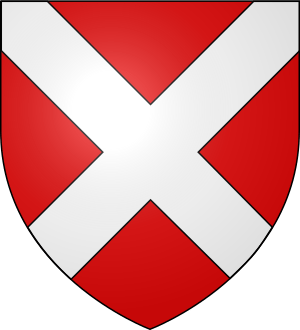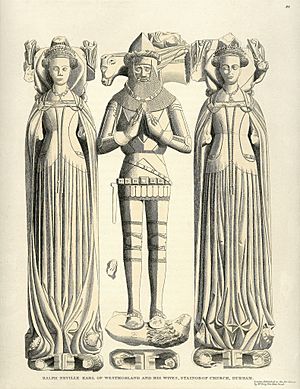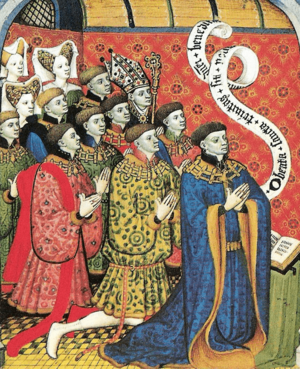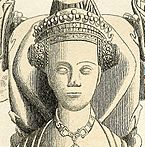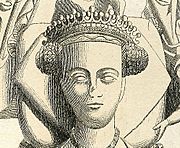Ralph Neville, 1st Earl of Westmorland facts for kids
Quick facts for kids
Ralph Neville
|
|
|---|---|
| 1st Earl of Westmorland 4th Baron Neville de Raby |
|

Ralph Neville, 1st Earl of Westmorland, wearing the Lancastrian Collar of Esses; detail of his effigy at Staindrop Church, County Durham
|
|
| Born | c. 1364 |
| Died | 21 October 1425 (aged c. 61) |
| Buried | 1425 Staindrop Church, County Durham |
| Family | House of Neville |
| Spouse(s) | Margaret Stafford (m. 1383; d. 1396) Joan Beaufort (m. 1396) |
| Issue more... |
|
| Father | John, 3rd Baron Neville |
| Mother | Maud Percy |
Ralph Neville, 1st Earl of Westmorland (around 1364 – 21 October 1425), was an important English nobleman from the House of Neville. He was a powerful figure during the reigns of King Richard II and King Henry IV. He was also a Knight of the Garter, a special honor given by the King.
Contents
Early Life and Family
Ralph Neville was born around 1364. His father was John Neville, 3rd Baron Neville, and his mother was Maud Percy. His mother was from the powerful Percy family.
Ralph had a younger brother and five sisters. His brother, Thomas Neville, became the 5th Baron Furnivall. Ralph also had a half-brother and a half-sister from his father's second marriage.
A Life of Service and Power
Ralph Neville began his military career in France in 1380. He was knighted by King Richard II's uncle, Thomas of Woodstock. This meant he was given the title "Sir."
When he was 24, Ralph inherited his father's title, becoming the 4th Baron Neville de Raby. He was called to join the English Parliament, which is like a government meeting, from 1389. He also helped with peace talks with Scotland.
Becoming an Earl
In 1397, King Richard II rewarded Ralph Neville by making him the Earl of Westmorland. This was a very important title. However, Ralph's loyalty to the King was soon tested.
Ralph's second wife, Joan Beaufort, was the daughter of John of Gaunt, 1st Duke of Lancaster. John of Gaunt was King Richard's uncle. When King Richard banished John of Gaunt's son, Henry Bolingbroke, Ralph Neville chose to support his new brother-in-law.
Supporting a New King
In 1399, Henry Bolingbroke returned to England and took the throne, becoming King Henry IV. Ralph Neville was there to support him. For his help, King Henry IV gave Ralph many rewards. He was made the Earl Marshal, a high-ranking officer, for life. He also joined the King's special council.
In 1403, Ralph Neville became a Knight of the Garter. This is one of the most important honors in England.
Rivalry with the Percys
During King Henry IV's early reign, the powerful Percy family controlled the borders with Scotland. This led to a rivalry between the Neville and Percy families.
In 1403, the Percys rebelled against King Henry IV. Their leader, Henry "Hotspur" Percy, was killed in battle. After this, King Henry asked Ralph Neville to stop the remaining Percy army in the north. Ralph successfully pushed them back. As a reward, he was given control of the western border with Scotland.
Two years later, the Percy family rebelled again. Ralph Neville quickly gathered an army. He defeated some of their allies and then marched towards York. He faced a large army led by Archbishop Richard Scrope. Ralph was outnumbered, so he used a clever trick. He made Scrope and his allies believe that their demands would be met and they would be safe. Once Scrope's army disbanded, Scrope and his friends were arrested.
Ralph Neville handed them over to the King. He was not involved in their quick trial and execution. Instead, he was sent to take control of the Percy castles. For his success in ending the rebellion without much fighting, Ralph Neville received many of the former Percy lands.
Later Years and Royal Council
After King Henry IV died, Ralph Neville continued to defend the northern border as the Warden of the West March. In 1415, he won an important battle against a Scottish army.
Ralph Neville did not join King Henry V in his wars in France. After King Henry V died, Ralph Neville became a member of the Regency Council. This council helped rule England while the new king, King Henry VI, was still a child.
Ralph Neville was also known for building. He rebuilt Sheriff Hutton Castle and made changes to Raby Castle. He also helped found a college at Staindrop and likely built Penrith castle.
Marriages and Children
Ralph Neville married two times and had 22 children!
First Marriage
His first wife was Margaret de Stafford. They had two sons and six daughters:
- Maud Neville
- Alice Neville
- Philippa Neville
- Sir John Neville (who died before his father)
- Elizabeth Neville
- Anne Neville
- Sir Ralph Neville
- Margaret Neville
Second Marriage
His second wife was Joan Beaufort. She was the daughter of John of Gaunt, 1st Duke of Lancaster, making her a granddaughter of King Edward III. They had nine sons and five daughters:
- Katherine Neville
- Eleanor Neville
- Richard Neville, whose son was Richard Neville, "The Kingmaker"
- Henry Neville
- Robert Neville, who became a bishop
- William Neville
- John Neville
- George Neville
- Anne Neville
- Thomas Neville
- Cuthbert Neville
- Joan Neville, who became a nun
- Edward Neville
- Cecily Neville (1415–1495), who was the mother of King Edward IV and King Richard III.

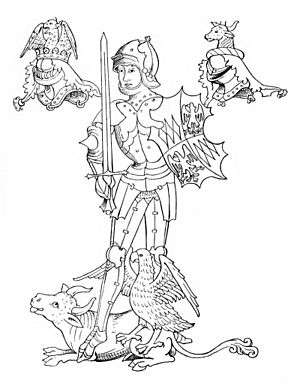
Death and Burial
Ralph Neville died on 21 October 1425. He was buried in the church at Staindrop. His tomb is a beautiful stone monument with statues of himself and his two wives. His first wife, Margaret Stafford, was buried in Brancepeth, and his second wife, Joan Beaufort, was buried in Lincoln Cathedral.
Because his eldest son, John Neville, died before him, Ralph was succeeded by his grandson, Ralph Neville, 2nd Earl of Westmorland.
Ralph Neville in Shakespeare
Ralph Neville is a character in some of Shakespeare's plays, including Henry IV, Part 1, Henry IV, Part 2, and Henry V.
In Henry IV, Part 1, he is shown as an ally of King Henry IV against the Percy family. In Henry IV, Part 2, he is shown as the one who cleverly ended the Percy rebellion in 1405.
However, in Henry V, Shakespeare takes some historical liberties. For example, in the play, Westmorland is shown arguing against war with France, but in real life, he was not part of that discussion. Also, a famous line about wishing for more soldiers before the Agincourt is given to Westmorland in the play, but he was not actually with King Henry V in France at that time. He was in England, helping to govern the country.


